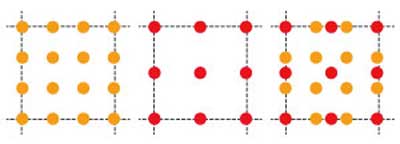| Posted: Apr 05, 2017 |
The perfect pattern to trap light
(Nanowerk News) Brighter LEDs and more efficient solar cells are two potential applications for A*STAR's research into lattice structures that can slow or trap light.
|
|
Harnessing wave energy by localizing it and suppressing its propagation through a medium is a powerful technique. Now, Alagappin Gandhi and Png Ching Eng Jason from the A*STAR Institute of High Performance Computing have calculated a design that localizes light in tiny loops, within a two-dimensional structure created by merging two lattices of slightly differing periodicities (Scientific Reports, "Localization of waves in merged lattices").
|
 |
| Two finite lattices of slightly different periodicities were merged to create a single primitive unit cell of a new superlattice called Merged Lattice. (Reproduced from Ref. 1 and licensed under CC BY 4.0 © 2016 G. Alagappan & C. E. Png)
|
|
The new technique is not limited to light, and may enable the design of systems that can precisely control wave energy in any realm and at any scale — sound, thermal, water, or even matter waves such as in Bose-Einstein condensates.
|
|
For light-based devices the new insights could be used to build more efficient photonic components, said Gandhi.
|
|
“If you pattern the surface of an LED with merged lattices it will assist with getting the light out efficiently,” said Gandhi. “For a solar cell, however merged lattices will help light to enter better so that more energy can be harvested.”
|
|
The ability to create resonators in which light is localized on the surface of a device also has applications in quantum computing components based on light, such as defects in diamond.
|
|
Gandhi and Png designed the structures by superimposing lattices of small circular dielectric materials with periods in a simple ratio R:R-1 — for example one lattice is merged with another whose spacing is 4/3 as big, or 5/4, 6/5 etc.
|
|
“It creates a two-dimensional effect similar to beats between two waves of very close frequency,” Gandhi said. “Where there are antinodes the light is localized in the form of a closed path.”
|
|
Gandhi said the creation of a regular array of localized loops of light contrasted with Anderson Localization, which arises from randomness in a structure. “This is a systematic way of creating a large number of loops,” Gandhi said.
|
|
Gandhi and Png ran numerical simulations of the propagation of light in a range of wavelengths slightly below that of the lattice spacing, and calculated the energy band structure. They found that as R increased, there emerged a large number of energy bands whose light had a group velocity of zero, the signature of light localized within the crystal.
|
|
Gandhi said merged lattices would also provide a way for researchers to explore topological properties, such as protected edge modes.
|

